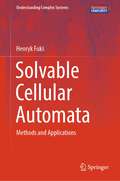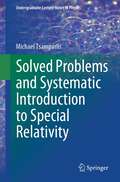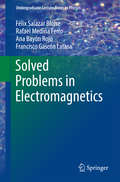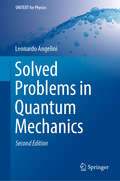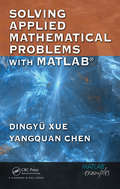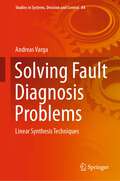- Table View
- List View
Solutions to Financial Economics: Exercises on Classical and Behavioral Finance (Springer Texts in Business and Economics)
by Thorsten Hens Marc Oliver RiegerThis book offers a concise introduction to the field of financial economics and presents, for the first time, recentbehavioral finance research findings that help us to understand many puzzles in traditional finance. Tailor-made formaster’s and PhD students, it includes tests and exercises that enable students to keep track of their progress. Parts of the book can also be used at the bachelor level.
Solvability, Regularity, and Optimal Control of Boundary Value Problems for PDEs: In Honour of Prof. Gianni Gilardi (Springer INdAM Series #22)
by Pierluigi Colli Angelo Favini Elisabetta Rocca Giulio Schimperna Jürgen SprekelsThis volume gathers contributions in the field of partial differential equations, with a focus on mathematical models in phase transitions, complex fluids and thermomechanics. These contributions are dedicated to Professor Gianni Gilardi on the occasion of his 70th birthday. It particularly develops the following thematic areas: nonlinear dynamic and stationary equations; well-posedness of initial and boundary value problems for systems of PDEs; regularity properties for the solutions; optimal control problems and optimality conditions; feedback stabilization and stability results. Most of the articles are presented in a self-contained manner, and describe new achievements and/or the state of the art in their line of research, providing interested readers with an overview of recent advances and future research directions in PDEs.
Solvability Theory of Boundary Value Problems and Singular Integral Equations with Shift (Mathematics and Its Applications #523)
by Georgii S. LitvinchukThe first formulations of linear boundary value problems for analytic functions were due to Riemann (1857). In particular, such problems exhibit as boundary conditions relations among values of the unknown analytic functions which have to be evaluated at different points of the boundary. Singular integral equations with a shift are connected with such boundary value problems in a natural way. Subsequent to Riemann's work, D. Hilbert (1905), C. Haseman (1907) and T. Carleman (1932) also considered problems of this type. About 50 years ago, Soviet mathematicians began a systematic study of these topics. The first works were carried out in Tbilisi by D. Kveselava (1946-1948). Afterwards, this theory developed further in Tbilisi as well as in other Soviet scientific centers (Rostov on Don, Ka zan, Minsk, Odessa, Kishinev, Dushanbe, Novosibirsk, Baku and others). Beginning in the 1960s, some works on this subject appeared systematically in other countries, e. g. , China, Poland, Germany, Vietnam and Korea. In the last decade the geography of investigations on singular integral operators with shift expanded significantly to include such countries as the USA, Portugal and Mexico. It is no longer easy to enumerate the names of the all mathematicians who made contributions to this theory. Beginning in 1957, the author also took part in these developments. Up to the present, more than 600 publications on these topics have appeared.
Solvable Algebras of Pseudodifferential Operators (Pseudo-Differential Operators #15)
by Boris Plamenevskii Oleg SarafanovThis book presents original research results on pseudodifferential operators.C*-algebras generated by pseudodifferential operators with piecewise smooth symbols on a smooth manifold are considered. For each algebra, all the equivalence classes of irreducible representations are listed; as a consequence, a criterion for a pseudodifferential operator to be Fredholm is stated, the topology on the spectrum is described, and a solving series is constructed.Pseudodifferential operators on manifolds with edges are introduced, their properties are considered in details, and an algebra generated by the operators is studied.An introductory chapter includes all necessary preliminaries from the theory of pseudodifferential operators and C*-algebras.
Solvable Cellular Automata: Methods and Applications (Understanding Complex Systems)
by Henryk FukśThe main focus of the book is solvability of cellular automata, that is, expressing the state of a given cell after a given number of steps by an explicit formula. The author considers solutions of two types of initial value problems for cellular automata, the deterministic one and the probabilistic one. In the first chapter the basic concepts of cellular automata theory are introduced. Deterministic initial value problem is introduced next and solutions for selected simple rules are also presented. In the following chapters various techniques for solving the deterministic problem are introduced, using elementary CA rules of increasing complexity as examples. The second part of the book introduces the concept of probability measure in the context of cellular automata and the probabilistic initial value problem for both deterministic and probabilistic rules. The book is amply illustrated with examples and applications such as the density classification problem, phase transitions in traffic models or the diffusion of innovations model. In the appendix, solution formulae (both deterministic and probabilistic) for over 60 elementary cellular automata rules are listed. Ruelle-Frobenius-Perron equations for all 88 minimal elementary cellular automata are also provided.
Solvable One-Dimensional Multi-State Models for Statistical and Quantum Mechanics
by Rajendran Saravanan Aniruddha ChakrabortyThis book highlights the need for studying multi-state models analytically for understanding the physics of molecular processes. An intuitive picture about recently solved models of statistical and quantum mechanics is drawn along with presenting the methods developed to solve them. The models are relevant in the context of molecular processes taking place in gaseous phases and condensed phases, emphasized in the introduction. Chapter 1 derives the arisal of multi-state models for molecular processes from the full Hamiltonian description. The model equations are introduced and the literature review presented in short. In Chapter 2, the time-domain methods to solve Smoluchowski-based reaction-diffusion systems with single-state and two-state descriptions are discussed. Their corresponding analytical results derive new equilibrium concepts in reversible reactions and studies the effect of system and molecular parameters in condensed-phase chemical dynamics. In Chapter 3, time-domain methods to solve quantum scattering problems are developed. Along side introducing a brand new solvable model in quantum scattering, it discusses transient features of quantum two-state models. In interest with electronic transitions, a new solvable two-state model with localized non-adiabatic coupling is also presented. The book concludes by proposing the future scope of the model, thereby inviting new research in this fundamentally important and rich applicable field.
Solved and Unsolved Problems of Structural Chemistry
by Milan RandicSolved and Unsolved Problems of Structural Chemistry introduces new methods and approaches for solving problems related to molecular structure. It includes numerous subjects such as aromaticity-one of the central themes of chemistry-and topics from bioinformatics such as graphical and numerical characterization of DNA, proteins, and proteomes. It a
Solved Exercises in Fractional Calculus (Studies in Systems, Decision and Control #240)
by Edmundo Capelas de OliveiraThis book contains a brief historical introduction and state of the art in fractional calculus. The author introduces some of the so-called special functions, in particular, those which will be directly involved in calculations. The concepts of fractional integral and fractional derivative are also presented. Each chapter, except for the first one, contains a list of exercises containing suggestions for solving them and at last the resolution itself. At the end of those chapters there is a list of complementary exercises. The last chapter presents several applications of fractional calculus.
Solved Problems and Systematic Introduction to Special Relativity (Undergraduate Lecture Notes in Physics)
by Michael TsamparlisIn most undergraduate physics classes Special Relativity is taught from a simplistic point of view using Newtonian concepts rather than the relativistic way of thinking. This results in students often finding it difficult to understand properly the new approach/new ideas, and consequently to solve relativistic problems. Furthermore, a number of books treat the theory using advanced mathematics which is not necessary for the first approach to the theory. This book is intended to serve two roles: a. To treat a student in a systematic constructive way to the basic structure of the theory and b. To provide a large number of solved in-detail problems in the kinematics and dynamics of Special Relativity. Concerning the first aim the book introduces the basics of four-dimensional mathematics, i.e., Lorentz metric, relativistic tensors, and prepares, through working examples, the transition to General Relativity, which requires, besides the relativistic concepts, the use of Differential Geometry and tensor analysis. The presentation is concise and does not replace a book on Special Relativity. Concerning the second intention the large number of problems provides the necessary material which can be used in order to familiarize the student with the relativistic “world”. These problems can be used in the class by the teachers either as working examples or as problem sheets. It will be our pleasure if the book will be useful to both students and teachers.
Solved Problems in Electromagnetics (Undergraduate Lecture Notes in Physics)
by Félix Salazar Bloise Rafael Medina Ferro Ana Bayón Rojo Francisco Gascón LatasaThis book presents the fundamental concepts of electromagnetism through problems with a brief theoretical introduction at the beginning of each chapter. The present book has a strong didactic character. It explains all the mathematical steps and the theoretical concepts connected with the development of the problem. It guides the reader to understand the employed procedures to learn to solve the exercises independently.The exercises are structured in a similar way: The chapters begin with easy problems increasing progressively in the level of difficulty. This book is written for students of physics and engineering in the framework of the new European Plans of Study for Bachelor and Master and also for tutors and lecturers.
Solved Problems in Geostatistics
by Oy Leuangthong K. Daniel Khan Clayton V. DeutschThis unique book presents a learn-by-doing introduction to geostatistics. Geostatistics provides the essential numerical tools for addressing research problems that are encountered in fields of study such as geology, engineering, and the earth sciences. Illustrating key methods through both theoretical and practical exercises, Solved Problems in Geostatistics is a valuable and well-organized collection of worked-out problems that allow the reader to master the statistical techniques for modeling data in the geological sciences. The book's scope of coverage begins with the elements from statistics and probability that form the foundation of most geostatistical methodologies, such as declustering, debiasing methods, and Monte Carlo simulation. Next, the authors delve into three fundamental areas in conventional geostatistics: covariance and variogram functions; kriging; and Gaussian simulation. Finally, special topics are introduced through problems involving utility theory, loss functions, and multiple-point geostatistics. Each topic is treated in the same clearly organized format. First, an objective presents the main concepts that will be established in the section. Next, the background and assumptions are outlined, supplying the comprehensive foundation that is necessary to begin work on the problem. A solution plan demonstrates the steps and considerations that have to be taken when working with the exercise, and the solution allows the reader to check their work. Finally, a remarks section highlights the overarching principles and noteworthy aspects of the problem. Additional exercises are available via a related Web site, which also includes data related to the book problems and software programs that facilitate their resolution. Enforcing a truly hands-on approach to the topic, Solved Problems in Geostatistics is an indispensable supplement for courses on geostatistics and spatial statistics a the upper-undergraduate and graduate levels.It also serves as an applied reference for practicing professionals in the geosciences.
Solved Problems in Lagrangian and Hamiltonian Mechanics
by Claude Gignoux Bernard Silvestre-BracThe aim of this work is to bridge the gap between the well-known Newtonian mechanics and the studies on chaos, ordinarily reserved to experts. Several topics are treated: Lagrangian, Hamiltonian and Jacobi formalisms, studies of integrable and quasi-integrable systems. The chapter devoted to chaos also enables a simple presentation of the KAM theorem. All the important notions are recalled in summaries of the lectures. They are illustrated by many original problems, stemming from real-life situations, the solutions of which are worked out in great detail for the benefit of the reader. This book will be of interest to undergraduate students as well as others whose work involves mechanics, physics and engineering in general.
Solved Problems in Quantum and Statistical Mechanics (UNITEXT)
by Michele Cini Francesco Fucito Mauro SbragagliaThis textbook is the result of many years of teaching quantum and statistical mechanics, drawing on exercises and exam papers used on courses taught by the authors. The subjects of the exercises have been carefully selected to cover all the material which is most needed by students. Each exercise is carefully solved in full details, explaining the theory behind the solution with particular care for those issues that students often find difficult, or which are often neglected in other books on the subject. The exercises in this book never require extensive calculations but tend to be somewhat unusual and force the solver to think about the problem starting from first principles, rather than by analogy with some previously solved exercise.
Solved Problems in Quantum Mechanics (UNITEXT for Physics)
by Leonardo AngeliniThis book presents a large collection of problems in Quantum Mechanics that are solvable within a limited time and using simple mathematics. The problems test both the student’s understanding of each topic and their ability to apply this understanding concretely. Solutions to the problems are provided in detail, eliminating only the simplest steps. No problem has been included that requires knowledge of mathematical methods not covered in standard courses, such as Fuchsian differential equations. The book is in particular designed to assist all students who are preparing for written examinations in Quantum Mechanics, but will also be very useful for teachers who have to pose problems to their students in lessons and examinations.
Solved Problems in Thermodynamics and Statistical Physics
by Gregor Skačej Primož ZiherlThis book contains a modern selection of about 200 solved problems and examples arranged in a didactic way for hands-on experience with course work in a standard advanced undergraduate/first-year graduate class in thermodynamics and statistical physics. The principles of thermodynamics and equilibrium statistical physics are few and simple, but their application often proves more involved than it may seem at first sight. This book is a comprehensive complement to any textbook in the field, emphasizing the analogies between the different systems, and paves the way for an in-depth study of solid state physics, soft matter physics, and field theory.
Solvency: Models, Assessment and Regulation
by Arne SandstromUntil now there were no published analyses of the recent solvency work conducted in Europe, specifically the risk categories proposed by the International Actuarial Association (IAA). Answering the insurance industry's demand in the wake of the EU Solvency II project, Solvency: Models, Assessment and Regulation provides a concrete summary and revie
Solvency II in the Insurance Industry: Application of a Non-Life Data Model (Contributions to Management Science)
by Maria Heep-Altiner Martin Mullins Torsten RohlfsThis book illustrates the EU-wide Solvency II framework for the insurance industry, which was implemented on January 1, 2016, after a long project phase. Analogous to the system for banks, it is based on three pillars and the authors analyze the complete framework pillar by pillar with a consistent data model for a non-life insurer, which was developed by the Research Group Financial & Actuarial Risk Management (FaRis) at the Institute for Insurance Studies of the TH Köln - University of Applied Sciences. The book leverages the long-standing and close cooperation between the University of Limerick (Ireland) and the Institute for Insurance Studies at TH Köln - University of Applied Sciences (Germany).
Solving Applied Mathematical Problems with MATLAB (PDF)
by Dingyu XueThis textbook presents a variety of applied mathematics topics in science and engineering with an emphasis on problem solving techniques using MATLAB. The authors provide a general overview of the MATLAB language and its graphics abilities before delving into problem solving, making the book useful for readers without prior MATLAB experi
Solving Computationally Expensive Engineering Problems: Methods and Applications (Springer Proceedings in Mathematics & Statistics #97)
by Slawomir Koziel Leifur Leifsson Xin-She YangComputational complexity is a serious bottleneck for the design process in virtually any engineering area. While migration from prototyping and experimental-based design validation to verification using computer simulation models is inevitable and has a number of advantages, high computational costs of accurate, high-fidelity simulations can be a major issue that slows down the development of computer-aided design methodologies, particularly those exploiting automated design improvement procedures, e.g., numerical optimization. The continuous increase of available computational resources does not always translate into shortening of the design cycle because of the growing demand for higher accuracy and necessity to simulate larger and more complex systems. Accurate simulation of a single design of a given system may be as long as several hours, days or even weeks, which often makes design automation using conventional methods impractical or even prohibitive. Additional problems include numerical noise often present in the simulation data, possible presence of multiple locally optimum designs, as well as multiple conflicting objectives. In this edited book, various techniques that can alleviate solving computationally expensive engineering design problems are presented. One of the most promising approaches is the use of fast replacement models, so-called surrogates, that reliably represent the expensive, simulation-based model of the system/device of interest but they are much cheaper and analytically tractable. Here, a group of international experts summarize recent developments in the area and demonstrate applications in various disciplines of engineering and science. The main purpose of the work is to provide the basic concepts and formulations of the surrogate-based modeling and optimization paradigm, as well as discuss relevant modeling techniques, optimization algorithms and design procedures. Therefore, this book should be useful to researchers and engineers from any discipline where computationally heavy simulations are used on daily basis in the design process.
Solving Differential Equations in R (Use R!)
by Karline Soetaert Jeff Cash Francesca MazziaMathematics plays an important role in many scientific and engineering disciplines. This book deals with the numerical solution of differential equations, a very important branch of mathematics. Our aim is to give a practical and theoretical account of how to solve a large variety of differential equations, comprising ordinary differential equations, initial value problems and boundary value problems, differential algebraic equations, partial differential equations and delay differential equations. The solution of differential equations using R is the main focus of this book. It is therefore intended for the practitioner, the student and the scientist, who wants to know how to use R for solving differential equations. However, it has been our goal that non-mathematicians should at least understand the basics of the methods, while obtaining entrance into the relevant literature that provides more mathematical background. Therefore, each chapter that deals with R examples is preceded by a chapter where the theory behind the numerical methods being used is introduced. In the sections that deal with the use of R for solving differential equations, we have taken examples from a variety of disciplines, including biology, chemistry, physics, pharmacokinetics. Many examples are well-known test examples, used frequently in the field of numerical analysis.
Solving Elliptic Problems Using ELLPACK (Springer Series in Computational Mathematics #2)
by John R. Rice Ronald F. BoisvertELLP ACK is a many faceted system for solving elliptic partial differential equations. It is a forerunner of the very high level, problem solving environments or expert systems that will become common in the next decade. While it is still far removed from the goals of the future, it is also far advanced compared to the Fortran library approach in common current use. Many people will find ELLP ACK an easy way to solve simple or moderately complex elliptic problems. Others will be able to solve really hard problems by digging a little deeper into ELLP ACK. ELLP ACK is a research tool for the study of numerical methods for solving elliptic problems. Its original purpose was for the evaluation and comparison of numerical software for elliptic problems. Simple examples of this use are given in Chapters 9-11. The general conclusion is that there are many ways to solve most elliptic problems, there are large differences in their efficiency and the most common ways are often less efficient, sometimes dramatically so.
Solving Fault Diagnosis Problems: Linear Synthesis Techniques (Studies in Systems, Decision and Control #84)
by Andreas VargaThis book addresses fault detection and isolation topics from a computational perspective. Unlike most existing literature, it bridges the gap between the existing well-developed theoretical results and the realm of reliable computational synthesis procedures. The model-based approach to fault detection and diagnosis has been the subject of ongoing research for the past few decades. While the theoretical aspects of fault diagnosis on the basis of linear models are well understood, most of the computational methods proposed for the synthesis of fault detection and isolation filters are not satisfactory from a numerical standpoint. Several features make this book unique in the fault detection literature: Solution of standard synthesis problems in the most general setting, for both continuous- and discrete-time systems, regardless of whether they are proper or not; consequently, the proposed synthesis procedures can solve a specific problem whenever a solution existsEmphasis on the best numerical algorithms to solve the synthesis problems for linear systems in generalized state-space form (also known as descriptor systems)Development of general synthesis procedures relying on new computational paradigms, such as factorization-based design based on filter updating techniques and nullspace-based synthesisAvailability of a comprehensive set of free accompanying software tools for descriptor systems, which allows readers to easily implement all synthesis procedures presented in the book and ensures that all results are reproducible This book is primarily intended for researchers and advanced graduate students in the areas of fault diagnosis and fault-tolerant control. It will also appeal to mathematicians with an interest in control-oriented numerics.
Solving Frontier Problems of Physics: The Decomposition Method (Fundamental Theories of Physics #60)
by G. AdomianThe Adomian decomposition method enables the accurate and efficient analytic solution of nonlinear ordinary or partial differential equations without the need to resort to linearization or perturbation approaches. It unifies the treatment of linear and nonlinear, ordinary or partial differential equations, or systems of such equations, into a single basic method, which is applicable to both initial and boundary-value problems. This volume deals with the application of this method to many problems of physics, including some frontier problems which have previously required much more computationally-intensive approaches. The opening chapters deal with various fundamental aspects of the decomposition method. Subsequent chapters deal with the application of the method to nonlinear oscillatory systems in physics, the Duffing equation, boundary-value problems with closed irregular contours or surfaces, and other frontier areas. The potential application of this method to a wide range of problems in diverse disciplines such as biology, hydrology, semiconductor physics, wave propagation, etc., is highlighted. For researchers and graduate students of physics, applied mathematics and engineering, whose work involves mathematical modelling and the quantitative solution of systems of equations.
Solving Higher-Order Equations: From Logic to Programming (Progress in Theoretical Computer Science)
by Christian PrehoferThis monograph develops techniques for equational reasoning in higher-order logic. Due to its expressiveness, higher-order logic is used for specification and verification of hardware, software, and mathematics. In these applica tions, higher-order logic provides the necessary level of abstraction for con cise and natural formulations. The main assets of higher-order logic are quan tification over functions or predicates and its abstraction mechanism. These allow one to represent quantification in formulas and other variable-binding constructs. In this book, we focus on equational logic as a fundamental and natural concept in computer science and mathematics. We present calculi for equa tional reasoning modulo higher-order equations presented as rewrite rules. This is followed by a systematic development from general equational rea soning towards effective calculi for declarative programming in higher-order logic and A-calculus. This aims at integrating and generalizing declarative programming models such as functional and logic programming. In these two prominent declarative computation models we can view a program as a logical theory and a computation as a deduction.
Solving Hyperbolic Equations with Finite Volume Methods (UNITEXT #90)
by M. Elena Vázquez-CendónFinite volume methods are used in numerous applications and by a broad multidisciplinary scientific community. The book communicates this important tool to students, researchers in training and academics involved in the training of students in different science and technology fields. The selection of content is based on the author’s experience giving PhD and master courses in different universities. In the book the introduction of new concepts and numerical methods go together with simple exercises, examples and applications that contribute to reinforce them. In addition, some of them involve the execution of MATLAB codes. The author promotes an understanding of common terminology with a balance between mathematical rigor and physical intuition that characterizes the origin of the methods. This book aims to be a first contact with finite volume methods. Once readers have studied it, they will be able to follow more specific bibliographical references and use commercial programs or open source software within the framework of Computational Fluid Dynamics (CFD).




